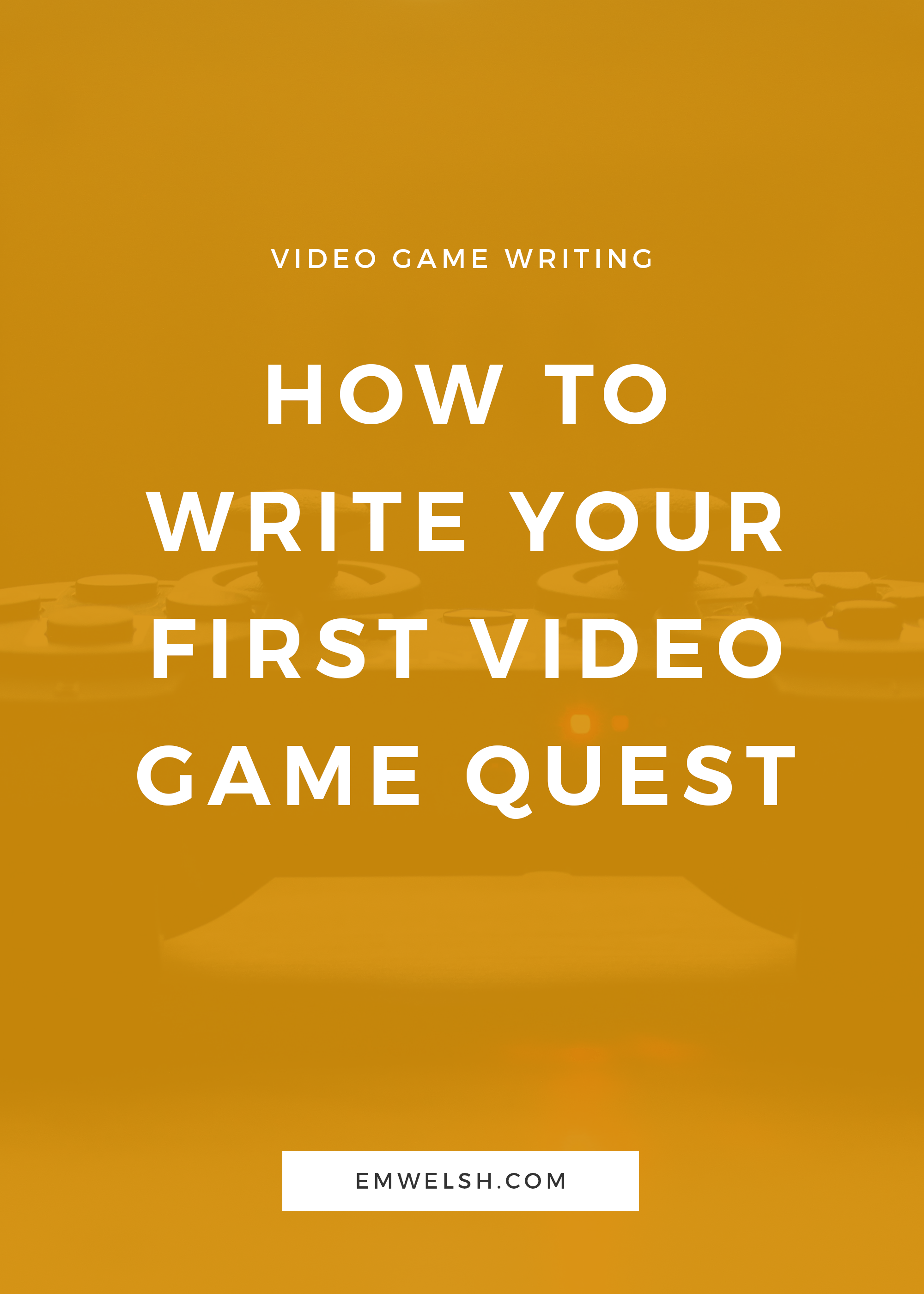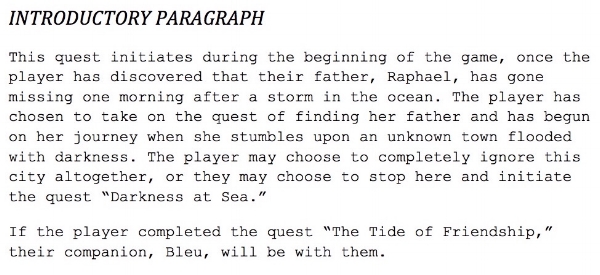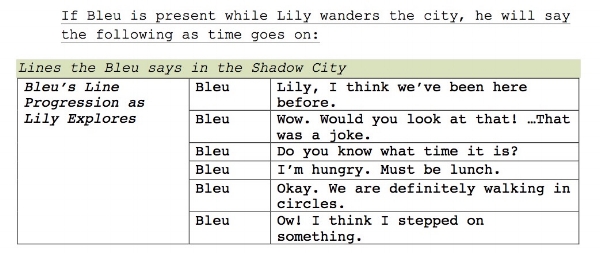How to Write Your First Video Game Quest
/When I first began navigating the world of video games in my adult years and unearthed the massive world of RPG gaming, I couldn't help but ask myself "What the heck does a script for this game look like?" After all, while I knew these games were written in a format similar to screenplays, I also realized that writers weren't just writing out one scene's dialogue, but all the different outcomes of that scenes dialogue, so I knew these scripts had to be massive to account for all the different possibilities.
To give you an example, one of my favorite games, The Witcher 3: Wild Hunt, is about 450,000 words long. When you play the game, with nearly every conversation you have a choice on how to best respond, oftentimes that very response determining the fate of characters later on (to my dismay). All of these possibilities are included in these 450,000 pages. Whether that includes in-game text (diary entries, character descriptions, glossaries, etc.) or not, I am not sure. But to compare, the average novel is around 80,000 to 100,000 words, making The Witcher 3 about the length of four novels. WHICH IS INSANE. The dialogue alone took two and a half years to record! Even if you think video games are absolutely stupid you have to appreciate the amount of work and dedication behind the medium.
Of course, there are other video games with much shorter and more straightforward scripts. But I am not here to talk about writing those types of scripts today. I am here to talk about branching dialogue scripts for video games, ones that have choices that determine how people react and whatnot. Usually these types of scripts are written for RPGs, but there are other games like the Telltale ones that using branching dialogue as well (if you have no idea what these things are, hop on over to my article on how video games help storytelling to refresh yourself).
If you are, however, interested in writing a straightforward game that's more like an interactive story and less like a choose-your-own-adventure, I suggest learning first how to write a screenplay, since these forms will be very similar. An example of a game like this is Bioshock, a game I love dearly and highly recommend, but not a game with branching dialogue.
I should clarify that I am by no means an expert in the business nor is the way I am teaching you to write a script for video games the only way to write one, or even the industry way. This is just the way I was taught in my class and the way I believe to be the best format for both myself and for someone else reading the script. You'll find that unlike screenwriting, there is no definite way (so far that I know) to write a video game script because each company does things differently. Your goal is instead to write a quest that's format makes the quest easy to visualize as an actual game without breaking the bank on any sort of programming.
Essentially, I wrote this for all the storytellers who are interested in writing video games but lack programming experience, because you need somewhere to practice the medium and I believe Word to be the best jumping point since nearly every writer has the program.
Now that I've cleared all of that up, I should also mention that I cannot on good conscious continue to write about how to do all of this without thanking my professor Sheldon Pacotti, the lead writer of Deus Ex (!!), for teaching me all of this! I really am just imitating him and the formats he showed us in class, so hopefully I can do his lectures justice!
Setting Up the Quest
Before you get to writing out your great adventure, there are a few less exciting steps you have to take to help make it easier on future readers to visualize the piece as a game and not a movie script. While you can technically write these out in Final Draft, I chose to write mine in Word because it allows me more freedom than Final Draft would, which is quite limiting in terms of dialogue branching.
Additionally, if you really intend to write out the entire video game (which would be amazing), I suggest writing out a summary or outline of the entire piece before you start attacking this quest. Because if you are like me and already have trouble keeping your own story straight in a novel or in a film, imagine how difficult it is to do it in a video game with various outcomes!
1.Introductory Paragraph
Assuming you already have a name for your game picked out, we will begin by writing a short introduction that sets things up for this quest. When you write an open world video game, the player can stumble upon quests in any order they choose, so it's really important to give the situation context. Below I have copied an example for a sample video game I wrote just for this blog post, so steal the idea to your heart's content!
There are no rules here on how to write this paragraph of course, only that the more information you put down the easier it'll be for you later on to tie this to other quests without having to reread the entire thing. For example, you can see I make mention of another quest that might alter the world situation. As a result, for the rest of this quest, I will be required to write "if" situations in my dialogue trees accounting for Bleu being there, something I will touch up on later. I also make mention of the possibility that the player might completely miss the quest "Darkness at Sea," so that later I would write out what happens if the player misses that quest and how it affects everything else.
Sounds complex and like a lot to keep up with, right? You can see why we're sticking to one quest now - for now.
2. Set Up the Location
If you've written a screenplay, you'll be familiar with this format on how to write out the location of the scene. But for those of you who don't know, I've provided an example as to how you'll write your locations out in a modified slug line form.
As you can see, this is the beginning of the quest. For your first quest we are going to write things out very streamlined and like the player is very focused and following the quest exactly as things might go. Of course, that's not how things games are usually played, but for the sake of learning the basics, we'll imagine that's how it is, because that's how you'll write it.
Of course, most quests are not limited to one location. That would be boring. So later, as your player enters spooky caves or luminous palaces, you'll have to let people know that in your video game script the same way, only you won't keep writing "Quest" over and over again like I did in the first example, because everything within this world takes place in this quest.
So for my game, Lily, my protagonist and the player, meets a guy named Sebastian. He asks her to visit his house, and so when she enters his house I would show it as such:
You'll notice I switched from "EXT" to "INT," which means switching from interior to exterior. But I also switched locations. In my game, Dynacora is the country my player was exploring, but they've now chosen to enter the city that initiates the "Darkness at Sea" quest, so to make things more clear I've changed my locations so that Swallow City is now the leading location.
3. First or Third Person?
This isn't a huge deal, but so as to better help people imagine what your game is doing, decide now whether your game will be first or third person. If you end up writing several quests, this won't even be included in each quest because it is very weird to switch from third to first person in a video game without justifiable reasons, so there's no need to keep repeating which viewpoint you're writing from. But for our exercise we are going to write out just underneath the first slug line either "FIRST PERSON GAME PLAY" or "THIRD PERSON GAME PLAY".
Simple enough, right? Now for what we've been waiting for...
The Fun Stuff
Barks
Barks are essentially random bits of dialogue either said by NPCs (non-playable characters) or companions that don't open up conversations. They are super fun to write and add a lot of texture to a game.
Here is an example of one for my game, in which I accidentally wrote 'Shadow City' instead of 'Swallow City.' (Please bear with me on these typos. Trying to create a video game quest while blogging about it at the same time is more difficult than one would imagine.)
You can write "barks" for everyone. NPCs you run into, NPCs who the player clicks on but who don't have a conversation option, NPCs you just pass by. The possibilities are endless!
Journals, Newsletters, and Other Odds Bits of Writing
These are items or other things that you can include in your video game script that maybe the player will pick up and can read in the menu. A great way to organize this is with an Excel spreadsheet in my opinion, or at least a chart in your Word document that mimics an Excel one. There, you can list out each item type, what it says, and in what quest the player finds it. Then, in your actual script for the quest you'll just list the item type by name.
For example, you'd write "IF the player picks up 'JANE'S LOVE LETTER'" and then you'd write the contents of that love letter in your little spreadsheet instead of the script, unless of course you decide you want there to be a cut-scene where your character reads the letter out loud in which case you'd just put the contents of the letter in the dialogue.
Cut-Scenes
Cut scenes for the most part, are just like writing dialogue in a screenplay, except that occasionally you'll have branching dialogue. However, even if you want your video game or your quest to have 25 different outcomes, you'll still need canons for the game to fall through that are for the most part the same, otherwise you will never be able to finish your game.
You may write multiple cut-scenes out depending on your dialogue trees, however, cut-scenes are usually scenes without any dialogue choices, making them a bit easier to write. Treat them like a bunch of mini screenplay scenes, formatting them with the slug line and then the dialogue (there are examples of dialogue formatting below).
The Dialogue Tree
This is where things get tricky, because while it's easy to set up one dialogue tree, juggling many of them becomes difficult to keep track of. As a result, I find examples to be the most fruitful way to learn about dialogue trees.
To set this scene up, the player and potentially Bleu, her companion, have followed Sebastian into his home to talk to him. The player then clicks on Sebastian (something you'd write into the action right before the example below) and then I write this:
Here we've made our first choice dialogue box. You'll notice I have written next to it "All questions may be exhausted" and highlighted the entire thing in green. That's my own personal symbol to tell the reader that a dialogue box is showing up. The second part lets the potential programmer know that each question can be asked and that it isn't a choice between these two answers, though the player can also choose not to ask any questions at all.
In the next example, one of the questions answered in the first dialogue box prompts another exchange and another choice dialogue, but this time the player must choose between one of two ways to respond, each yielding unique information from Sebastian that changes the shape of the quest:
As you can see, the format is much like the first dialogue box, only I put this time that "Only one choice may be selected." Additionally, you'll notice a new part highlighted in orange. The color, as mentioned, does not matter, but this is my way of keeping track of all the different conversations that come from each question in the first example. You also use this similar format (brackets and highlighting) to keep track of "IF" statements.
Here is an example of one:
You'll see I have an "if" statement referring all the way back to my first example of dialogue boxes, the second question the player can ask to gain information. Then, I've included another "if" statement so that if Bleu is with the player, he can initiate a mini side quest where you, Bleu and Sebastian go out to where the shadows are gone. That of course opens a whole new can of worms that I won't go into, but it essentially follows the same format. I just thought I'd show it to you since it's an example as to how a quest can also be missed if someone isn't present (Bleu).
"All versions pick up here" is a major phrase to keep in mind and keep track of. Hence the colors. This is your way of saying "all the "ifs" are done" essentially. For instance, if a quest has two different outcomes that affect the world in a different way, once those effects take place and you're back to your canon, you'd say "All versions pick up here." An example in The Witcher 3 is when you're between romancing Yennefer or Triss ( Triss is the obvious winner, duh) and you're preparing for battle, depending on your choices you'll either behave romantically towards one or the other. Your "if." However, there's still a battle at hand, so no matter who you chose, the rest of the plot will move on the same either way. Hence "All romance versions pick up here" or something of that sort.
I know that this is quite a lot to keep up with and I hope I haven't totally overwhelmed you. Some people do tree dialogues with diagrams instead because they are more visual, but for me that overwhelms me even more so I have found I prefer this method, but feel free to try out other forms to see what works for you. Keep in mind that since there are no real rules, it's about making things as clear as possible to the reader and (ideally) the future coder or creator of the game. However, I know that if you're like me and still want more guidance I have provided you with a template to write your own first quest, since sometimes it's better to learn by way of practice!
You can find the template here as a Google Doc. You'll just need to go to "File" > "Download."
Interested in how to tackle other forms of storytelling? Check out my newbie's guide to screenwriting in which I equip you with all the tools you need to start tackling your first script!










